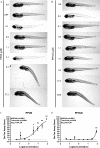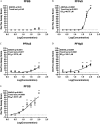Evaluation of Developmental Toxicity, Developmental Neurotoxicity, and Tissue Dose in Zebrafish Exposed to GenX and Other PFAS
- PMID: 32271623
- PMCID: PMC7228129
- DOI: 10.1289/EHP5843
Evaluation of Developmental Toxicity, Developmental Neurotoxicity, and Tissue Dose in Zebrafish Exposed to GenX and Other PFAS
Abstract
Background: Per- and polyfluoroalkyl substances (PFAS) are a diverse class of industrial chemicals with widespread environmental occurrence. Exposure to long-chain PFAS is associated with developmental toxicity, prompting their replacement with short-chain and fluoroether compounds. There is growing public concern over the safety of replacement PFAS.
Objective: We aimed to group PFAS based on shared toxicity phenotypes.
Methods: Zebrafish were developmentally exposed to 4,8-dioxa-3H-perfluorononanoate (ADONA), perfluoro-2-propoxypropanoic acid (GenX Free Acid), perfluoro-3,6-dioxa-4-methyl-7-octene-1-sulfonic acid (PFESA1), perfluorohexanesulfonic acid (PFHxS), perfluorohexanoic acid (PFHxA), perfluoro-n-octanoic acid (PFOA), perfluorooctanesulfonic acid (PFOS), or 0.4% dimethyl sulfoxide (DMSO) daily from 0-5 d post fertilization (dpf). At 6 dpf, developmental toxicity and developmental neurotoxicity assays were performed, and targeted analytical chemistry was used to measure media and tissue doses. To test whether aliphatic sulfonic acid PFAS cause the same toxicity phenotypes, perfluorobutanesulfonic acid (PFBS; 4-carbon), perfluoropentanesulfonic acid (PFPeS; 5-carbon), PFHxS (6-carbon), perfluoroheptanesulfonic acid (PFHpS; 7-carbon), and PFOS (8-carbon) were evaluated.
Results: PFHxS or PFOS exposure caused failed swim bladder inflation, abnormal ventroflexion of the tail, and hyperactivity at nonteratogenic concentrations. Exposure to PFHxA resulted in a unique hyperactivity signature. ADONA, PFESA1, or PFOA exposure resulted in detectable levels of parent compound in larval tissue but yielded negative toxicity results. GenX was unstable in DMSO, but stable and negative for toxicity when diluted in deionized water. Exposure to PFPeS, PFHxS, PFHpS, or PFOS resulted in a shared toxicity phenotype characterized by body axis and swim bladder defects and hyperactivity.
Conclusions: All emerging fluoroether PFAS tested were negative for evaluated outcomes. Two unique toxicity signatures were identified arising from structurally dissimilar PFAS. Among sulfonic acid aliphatic PFAS, chemical potencies were correlated with increasing carbon chain length for developmental neurotoxicity, but not developmental toxicity. This study identified relationships between chemical structures and in vivo phenotypes that may arise from shared mechanisms of PFAS toxicity. These data suggest that developmental neurotoxicity is an important end point to consider for this class of widely occurring environmental chemicals. https://doi.org/10.1289/EHP5843.
Figures












Similar articles
-
Investigation of Peroxisome Proliferator-Activated Receptor Genes as Requirements for Visual Startle Response Hyperactivity in Larval Zebrafish Exposed to Structurally Similar Per- and Polyfluoroalkyl Substances (PFAS).Environ Health Perspect. 2024 Jul;132(7):77007. doi: 10.1289/EHP13667. Epub 2024 Jul 24. Environ Health Perspect. 2024. PMID: 39046251 Free PMC article.
-
Legacy and alternative per- and polyfluoroalkyl substances (PFAS) alter the lipid profile of HepaRG cells.Toxicology. 2024 Aug;506:153862. doi: 10.1016/j.tox.2024.153862. Epub 2024 Jun 10. Toxicology. 2024. PMID: 38866127
-
Subtle morphometric, behavioral and gene expression effects in larval zebrafish exposed to PFHxA, PFHxS and 6:2 FTOH.Aquat Toxicol. 2019 Mar;208:126-137. doi: 10.1016/j.aquatox.2019.01.009. Epub 2019 Jan 14. Aquat Toxicol. 2019. PMID: 30669116 Free PMC article.
-
A review of cardiovascular effects and underlying mechanisms of legacy and emerging per- and polyfluoroalkyl substances (PFAS).Arch Toxicol. 2023 May;97(5):1195-1245. doi: 10.1007/s00204-023-03477-5. Epub 2023 Mar 22. Arch Toxicol. 2023. PMID: 36947184 Review.
-
Per and poly-fluoroalkyl substances (PFAS) as a contaminant of emerging concern in surface water: A transboundary review of their occurrences and toxicity effects.J Hazard Mater. 2021 Oct 5;419:126361. doi: 10.1016/j.jhazmat.2021.126361. Epub 2021 Jun 8. J Hazard Mater. 2021. PMID: 34157464 Review.
Cited by
-
Perfluorooctane Sulfonic Acid Disrupts Protective Tight Junction Proteins via Protein Kinase D in Airway Epithelial Cells.Toxicol Sci. 2022 Nov 23;190(2):215-226. doi: 10.1093/toxsci/kfac096. Toxicol Sci. 2022. PMID: 36106993 Free PMC article.
-
Insights into the Understanding of Adsorption Behaviors of Legacy and Emerging Per- and Polyfluoroalkyl Substances (PFASs) on Various Anion-Exchange Resins.Toxics. 2023 Feb 9;11(2):161. doi: 10.3390/toxics11020161. Toxics. 2023. PMID: 36851036 Free PMC article.
-
Per-and polyfluoroalkyl substances and disrupted sleep: mediating roles of proteins.Environ Adv. 2024 Oct;17:100585. doi: 10.1016/j.envadv.2024.100585. Epub 2024 Sep 17. Environ Adv. 2024. PMID: 39512894 Free PMC article.
-
Ursolic acid derivative UA312 ameliorates ionizing radiation-induced cardiotoxicity and neurodevelopmental toxicity in zebrafish via targeting chrna3 and grik5.Acta Pharmacol Sin. 2025 Apr 28. doi: 10.1038/s41401-025-01564-0. Online ahead of print. Acta Pharmacol Sin. 2025. PMID: 40295836
-
Evaluation of per- and polyfluoroalkyl substances (PFAS) in leachate, gas condensate, stormwater and groundwater at landfills.Chemosphere. 2023 Mar;318:137903. doi: 10.1016/j.chemosphere.2023.137903. Epub 2023 Jan 17. Chemosphere. 2023. PMID: 36669537 Free PMC article.
References
-
- Agier L, Basagaña X, Maitre L, Granum B, Bird PK, Casas M, et al. . 2019. Early-life exposome and lung function in children in Europe: an analysis of data from the longitudinal, population-based HELIX cohort. Lancet Planet Health 3(2):e81–e92, PMID: 30737192, 10.1016/S2542-5196(19)30010-5. - DOI - PubMed
-
- Apelberg BJ, Witter FR, Herbstman JB, Calafat AM, Halden RU, Needham LL, et al. . 2007. Cord serum concentrations of perfluorooctane sulfonate (PFOS) and perfluorooctanoate (PFOA) in relation to weight and size at birth. Environ Health Perspect 115(11):1670–1676, PMID: 18008002, 10.1289/ehp.10334. - DOI - PMC - PubMed
-
- Banks RE, Smart BE, Tatlow JC. 1994. Organofluorine Chemistry: Principles and Commercial Applications. 1st ed New York, NY: Springer US.
Publication types
MeSH terms
Substances
LinkOut - more resources
Full Text Sources

